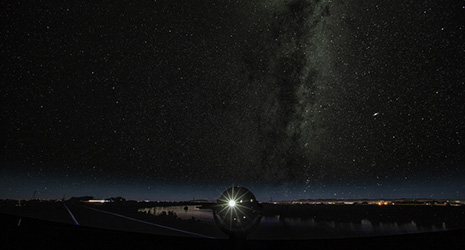February 2020
Beautiful Starry Skies Inside

A Japanese planetarium manufacturer with almost 100 years of history continues to attract visitors in Japan and overseas with its beautiful starry “skies.”
In 1910, Halley’s Comet passed close to earth on its roughly 75-year orbit of the sun. At that time, Goto Seizo, 19, who lived in Kochi Prefecture, was excited to see it in the sky, and the experience deepened his interest in astronomy. In 1926, Goto founded Goto Optical Mfg. Co. (now Goto Inc.) in Tokyo, beginning the development and sales of telescopes for the public.
“At that time, astronomy telescopes were very expensive, and only large research institutions such as astronomical observatories were able to possess them,” says the current president of the company, Goto Nobutaka, Seizo’s great-grandchild. “However, the telescope that Seizo created was compact, but with sufficient performance, and was also low-priced. He received a rush of orders.”

The company’s astronomy telescope was adopted for use in school science classes and held an 80 percent market share in Japan at one time, but Seizo began to explore the development of a totally new product around 1950.
Goto says, “I think my great-grandfather might have felt a sense of crisis because a small and medium-sized company like ours cannot compete with large companies in terms of volume production. At such time, he encountered a planetarium on an overseas visit to the United States.”
In those days, a well-known Germany-based optical instrument company was the only one manufacturing planetariums. However, a lens-type planetarium, completed by Goto in 1959, had performance equivalent to the existing German planetarium, and was sold at about one tenth the price. The planetarium attracted a great deal of attention around the world.
The company continued the development and volume production of a variety of planetariums from small to very large, delivering a large number of planetariums to astronomical observatories, museums and commercial facilities in Japan and around the world. One of its representative products is the Hybrid Planetarium, the world’s first planetarium system, developed in 2004, which integrates an optical mechanical projector and a full-dome digital video system. In addition, Chiron, which can project more than 140 million stars, was developed in 2010 and Chiron II using LED light sources was developed in 2012. Its upgraded version, Chiron III, renders all of the approximately 9,500 visible stars in their specific colors, reproducing not only their brightness, but also the color of the stars faithfully for the first time in the world.

Goto says, “Our company sticks to thorough manufacturing of our products because we want to make the starry sky that our planetarium projects closer to the real thing. Now, we are not able to see the Milky Way from central Tokyo, but if you climb mountains with clean skies, you can see a beautiful starry sky any time. We want as many people as possible to take an interest in the stars and outer space after their visit to a planetarium and be moved by the real beauty of the starry sky.”
The enthusiasm for the starry sky of the founder, who was charmed by Halley’s Comet and then began to manufacture an astronomy telescope of his own, is still alive today.

